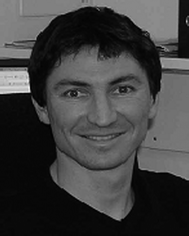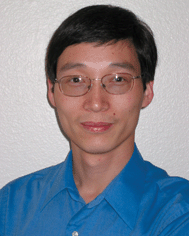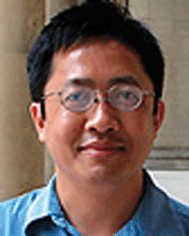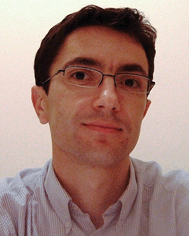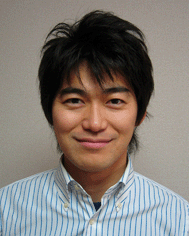DOI:
10.1039/C0MB90015J
(Profile)
Mol. BioSyst., 2010,
6, 1526-1531
Contributors to the Emerging Investigators issue
Claudia Blindauer studied Chemistry at the Albert-Ludwigs University (Freiburg im Breisgau, Germany), before moving on to work for her PhD degree with Prof. Helmut Sigel at the University of Basel, Switzerland, where she studied the metal-binding properties of antivirally active nucleotide analogues. In 1999, she moved to the University of Edinburgh, joining the group of Prof. Peter Sadler, holding post-doctoral fellowships from the Swiss National Science Foundation, the Novartis Foundation, and a European Commission Marie Curie Individual Fellowship. During this time, she studied the structure and dynamics of a variety of metal-binding proteins. In 2004, she took up her Royal Society Olga Kennard Fellowship, joining the Chemistry Department of the University of Warwick, where she also held an assistant professorship in Chemistry. She was promoted to Associate Professor in 2008. Her research interests center on proteins involved in metal ion homeostasis with a particular focus on zinc. This involves the combination of conventional bio-inorganic and structural biology methods, as well as the development of new analytical methods within the new research area of metallomics.
Elizabeth Boon is an Assistant Professor of Chemistry at Stony Brook University. She received her AB in Chemistry from Kenyon College in 1997 and her PhD in Chemistry from the California Institute of Technology in 2003. She then went to the University of California, Berkeley as an NIH postdoctoral fellow before joining the faculty at Stony Brook in 2006. At Stony Brook, the Boon Group is interested in understanding the biochemical mechanisms that regulate bacterial group behavior. Liz was the recipient of the James D. Watson Young Investigator Award, the Office of Naval Research Young Investigator Award, the ACS PROGRESS/Dreyfus Lectureship Award, the Rising Star Award from the Research Foundation of the State University of New York, and the Presidential Early Career Award for Scientists and Engineers (PECASE).
Colin Campbell is an EaStCHEM research fellow at the University of Edinburgh. His lab in the Division of Pathway Medicine conducts research whose ultimate goal is the integration of physical sciences and life sciences for the benefit of applications and understanding in medicine. Specifically his research falls into two areas: protein microarrays for the study of biomolecular interactions and diagnostics; and nanosensors for real-time, subcellular SERS imaging. He is an avid photographer and bagpipe player.
Dominic Campopiano was born in Glasgow, Scotland in 1967 and completed a BSc Honours degree in Chemistry at The University of Glasgow in 1988. He carried out research towards a PhD in Chemistry at The University of Edinburgh (1988–91) under the supervision of Professor Bob Baxter. He did post-doctoral research on antibiotic resistance with Professor Bill Shaw at the University of Leicester and on vitamin biosynthesis with Bob Baxter before taking up a lectureship at The University of Edinburgh in 1998. He held a Royal Society of Edinburgh/Scottish Executive Research Fellowship in 2006 and was promoted to senior lecturer in 2007. His research interests are in natural product biosynthesis, chemical biology, enzyme mechanism and protein structure. He is extremely pleased to have collaborators with expertise in various disciplines including; microbiology, immunology, genetics, mass spectrometry, NMR and X-ray crystallography.
Jörn Dengjel is a group leader at the Freiburg Institute for Advanced Studies (FRIAS), School of Life Sciences—LIFENET. He received his PhD in Biochemistry 2005 at the Department of Immunology, University of Tübingen. After one year at Immatics Biotechnologies, Tübingen, he spent three years as Postdoc at the Center for Experimental BioInformatics, University of Southern Denmark. Since 2008 he has been heading a research group situated at the Center for Biological Systems Analysis, University of Freiburg. His research focuses on the description of spatio-temporal protein dynamics during autophagy, a cellular degradation pathway, using quantitative mass spectrometry-based proteomics.
Ashok Deniz received his PhD in Chemistry from the University of Chicago, and then began postdoctoral training at the University of California, Berkeley. He is currently an Associate Professor in the Molecular Biology Department at The Scripps Research Institute in La Jolla, CA. His group develops and uses state of the art single molecule fluorescence methods to gain a deeper mechanistic understanding of folding, misfolding and assembly in biology. For example, one recent thrust is to understand the structural properties and binding folding interplay of the highly dynamic class of intrinsically disordered proteins, which are important in biology and health.
Ann Dixon is an Associate Professor of Chemical Biology at the University of Warwick, Coventry, UK. She received her BSc in Chemistry at the University of Plymouth (UK) in 1996, and her PhD in Chemistry in 2000 from the University of Kansas (USA). She was appointed as a Lecturer at the University of Warwick in 2005, and since then Dr Dixon's research team has focussed on the investigation of membrane protein structure, folding and interactions, with a special focus on transmembrane helix–helix interactions implicated in diseases such as cancer, diabetes, and heart disease. Her interests in this area were inspired by a postdoctoral fellowship at the National Institutes of Health in the lab of Tom Bull and Richard Pastor, as well as Yale University, where she was awarded an American Cancer Society Postdoctoral fellowship to train in the lab of Donald Engelman. Current work in her group involves the use and development of a wide variety of biophysical and biochemical methods to study membrane proteins of interest to human health, with the aim of better understanding the molecular mechanisms that lead to disease.
Robert Doyle was born in Dublin, Ireland and attended Trinity College, Dublin for both his BA in Natural Sciences and PhD in inorganic chemistry. He was an Enterprise Ireland predoctoral fellow in the lab of Prof. Paul E. Kruger, graduating in 2002. He then accepted an RSC fellowship to study at the Australian National University with Prof. N. Brasch. In 2003 he joined the lab of Prof. Ann M. Valentine at the department of Chemistry at Yale where he worked on the expression of nicatransferrin from
Ciona Intestinalis. He was awarded a Rudolph Anderson Foundation Fellowship while at Yale in 2004. He joined the faculty at Syracuse University as an Assistant Professor in the fall of 2005 and was promoted to Associate Professor with tenure in early 2009. His research interests include metal-citrate complex transport in Gram-positive bacteria, development of receptor specific metalloprobes and oral delivery of peptides and proteins. Amongst others, he has been funded by the ACS, NYSERDA and NIH as well as the Serum and Kauffman Foundations.
Ben Garcia received his BS in Chemistry from UC Davis and his PhD in Chemistry with Prof. Donald F. Hunt at the University of Virginia. He was then supported by an NIH NRSA Postdoctoral Fellowship at the University of Illinois, Urbana-Champaign, with Prof. Neil Kelleher. Ben joined the faculty at Princeton University in February 2008 where he is an Assistant Professor of Molecular Biology and Chemistry. His current interests include continued development of proteomic methodology for interrogating epigenetic signaling mechanisms. He was the recipient of an American Chemical Society Leadership Development award, a National Science Foundation Early Faculty CAREER award, and the American Society for Mass Spectrometry research award.
Jeff Gildersleeve obtained his BS degree in biology in 1993 from the University of California at San Diego. He obtained his PhD in organic chemistry at Princeton University under the guidance of Professor Dan Kahne and completed postdoctoral training with Professor Peter Schultz at The Scripps Research Institute. He is currently a Principal Investigator in the Chemical Biology Laboratory of the National Cancer Institute, NIH. The Gildersleeve lab identifies and studies carbohydrates that impact cancer biology, diagnosis, and treatment. The group focuses on developing glycan microarrays and applying this technology to cancer vaccine research. Outside of lab, he enjoys soccer, the Lakers, and shooting his kids with Nerf guns.
Kristina Håkansson was born and raised in Ludvika, Sweden and received MSc and PhD degrees in Molecular Biotechnology from Uppsala University, Sweden. She was a Swedish Foundation for International Cooperation in Research and Higher Education (STINT) postdoctoral fellow with Professor Alan G. Marshall at the National High Magnetic Field Laboratory, Florida State University. In 2003, she joined the faculty in Chemistry at the University of Michigan. Dr Håkansson received a Searle Scholar Award (2004), an American Society for Mass Spectrometry Research Award (2005), an Eli Lilly Analytical Chemistry Award (2005), and an NSF Career Award (2006). Her research interests are in Analytical Chemistry and Chemical Biology with a focus on biomolecular FT-ICR mass spectrometry, including carbohydrate structural determination and functional studies of natural product biosynthetic enzymes.
Stefan Howorka obtained his PhD degree from the University of Vienna and worked at Texas A&M University as a postdoctoral fellow in the group of Hagan Bayley. After a stint at an Austrian biotech incubator, he joined the Department of Chemistry at University College London in 2005 and has recently been promoted to Associate Professor/Reader. His current research interests are to use chemistry (i) to help enhance nanopore analytics, (ii) to facilitate the modification of solid substrates for sensing applications, and (iii) to investigate the molecular structure of self-assembling bacterial exoproteins.
Neil Kelleher received a BS and BA from Pacific Lutheran University in 1992, a Fulbright Fellowship the following year, and a PhD with Tadhg Begley and Fred McLafferty (Cornell University) in 1997. After a NIH Postdoctoral Fellowship with Chris Walsh (Harvard Medical School), Kelleher joined the faculty at the University of Illinois in 1999. He has received several awards including a Packard Fellowship, the NSF CAREER Award, the Lilly Analytical Chemistry Award, the Presidential Early Career Award in Science and Engineering (PECASE), the Biemann Medal (ASMS), and the Camille Dreyfus Teacher Scholar Award. He is a Sloan Fellow and has received support from the Burroughs-Wellcome, the Searle, and the Dreyfus Foundations. Kelleher has interests in mass spectrometry-based enzymology and “Top Down” proteomics using intact proteins for efficient detection of their post-translational modifications (such as those found in chromatin). Professor Kelleher begins his tenure at Northwestern University in January 2010 where he will serve as Professor of Chemistry and Biochemistry, Molecular Biology and Cell Biology (BMBCB). Within the Chemistry of Life Processes Institute, Neil will serve as the Faculty Director of the Proteomics Center of Excellence.
Sylvain Ladame was born in Ruffec, France in 1974. He received his PhD in Chemistry of Biomolecules in 2001 from the University of Toulouse, France. He then worked for five years in the group of Prof. Shankar Balasubramanian at the Chemistry Department of the University of Cambridge (UK) where he developed an interest in the molecular recognition of nucleic acids. In 2006, he joined the CNRS and the Institut de Science et d'Ingénierie Supramoléculaires (ISIS) at the University of Strasbourg, France, where he has been heading the junior research laboratory of “chemistry of biomolecules”. In July 2010, he has been appointed Joint Lecturer in Biosensor Development at the Institute of Biomedical Engineering and the Department of Bioengineering of Imperial College London. His current interests deal with the engineering of small molecules and proteins for sensing and targeting nucleic acid structures
in vivo.
Qing Lin received his BS in Chemistry from University of Science and Technology of China in 1994, and his PhD in Organic Chemistry from Yale University in 2000 under Professor Andrew Hamilton. He then worked in Professor Peter Schultz's lab at Scripps Research Institute as a Damon Runyon Postdoctoral Fellow. After a brief stay in industry, he joined the faculty of the State University of New York at Buffalo in 2005 where he is now an Assistant Professor of Chemistry. His current research interests include the development of (i) bioorthogonal reactions, (ii) enabling chemistries for peptide-based therapeutics, and (iii) protein-based organelles for synthetic biology applications.
Wenshe Liu received his BS in chemistry from Beijing University in 2000 and his PhD in biological chemistry from University of California-Davis, in 2005. His graduate work was under Dr Michael D. Toney studying the structures and catalytic mechanisms of pyridoxal 5′-phosphoate dependent enzymes. In 2005, he began his post-doctoral training with Dr Peter G. Schultz at The Scripps Research Institute and focused on designing methods to expand the genetic code in mammalian cells and understanding the structural basis of genetic code expansion. In 2007, he started as an Assistant Professor at the Chemistry Department of Texas A&M University. His current research interests center on understanding epigenetic roles of post-translational modifications and probing protein functions with genetically encoded noncanonical amino acids.
Danith Ly was born and raised in Cambodia. He received from Georgia Institute of Technology his Bachelor Degree in Chemical Engineering and Minor in Philosophy in 1994 and his PhD in Organic Chemistry for work under the supervision of Prof. Gary B. Schuster. He did postdoctoral work with Prof. Peter G. Schultz at the University of California at Berkeley and subsequently at the Scripps Research Institute at La Jolla. He joined the Department of Chemistry at Carnegie Mellon University in 2001 as an Assistant Professor, and is presently an Associate Professor of Chemistry. His research interests lie at the interface of chemistry and biology, with emphasis on gene regulation in human somatic and embryonic stem cells.
Juan C. Mareque-Rivas was born in Santiago de Compostela (Spain) in 1972. He obtained his BSc from the University of Santiago de Compostela (1995) and his PhD at the University of Missouri in St. Louis. After earning his PhD degree in 1999, he spent two years at the Massachusetts Institute of Technology as a postdoctoral researcher in the laboratory of Steve Lippard. He joined the School of Chemistry of the University of Edinburgh as Lecturer in 2000 and was promoted to senior lecturer in 2007. His current research uses synthetic chemistry to elucidate how molecules and groups of molecules work and interact in biological environments. His research aims at the development of improved therapies against cancer and infectious diseases and of bio-inspired methodologies for solar energy utilization and bio-/chemosensing applications.
Jin Montclare received her undergraduate BS degree in chemistry from Fordham University, Bronx, NY in 1997. She then went to Yale University, New Haven, CT as a NSF predoctoral fellow and earned her PhD in Bioorganic Chemistry under Alanna Schepartz in 2003 where she became fascinated by peptides and proteins. She embarked on an NIH postdoctoral fellowship at California Institute of Technology from 2003–2005 in the Division of Chemistry and Chemical Engineering with David Tirrell and was exposed to world of unnatural amino acids and biomaterials. From 2005, she began her position as an assistant professor in the Department of Chemical and Biological Sciences at Polytechnic Institute of New York University. She also has an adjunct position at SUNY Downstate Medical School in the Department of Biochemistry. Her research focuses on protein engineering of biocatalysts, therapeutics and biomaterials. One of her major goals is to convince the next generation of scientists and engineers of the awesome power of protein and molecular engineering. She has been awarded an Othmer fellowship, Weschler Award for Excellence, AFOSR Young Investigator Award, ACS/PROGRESS award and Dreyfus Special Grant.
Amy E. Palmer received her BA cum laude in 1994 from Dartmouth College where she worked with Karen E. Wetterhahn on the toxicity of chromium compounds. She received her PhD in 2001 in Chemistry from Stanford University, working under the direction of Edward I. Solomon characterizing the structure and function of multi-copper oxidases. From 2001–2005, Dr Palmer was an NIH-postdoctoral fellow in the lab of Roger Y. Tsien at the University of California San Diego. During this time she developed a family of genetically encoded fluorescent calcium sensors and used them to examine localized calcium signalling. Since 2005 she has been an Assistant Professor of Chemistry and Biochemistry at the University of Colorado-Boulder and a member of the Colorado Initiative in Molecular Biotechnology (CIMB). Her research focuses on developing fluorescent sensors for metal ions to probe metal distribution and dynamics in living cells, developing methodologies for imaging Salmonella pathogenesis, and using optically integrated microfluidics to optimize fluorescent probes. Dr Palmer is a 2010 Sloan Foundation Research Fellow.
Shinsuke Sando received his PhD (2001) from Kyoto University in bioorganic chemistry under the supervision of Prof. Isao Saito, and he was a post-doctoral fellow in the laboratory of Prof. Eric T. Kool at Stanford University, where he investigated RNA-templated chemistry. In 2002, he joined the laboratory of Prof. Yasuhiro Aoyama at Kyoto University as an Assistant Professor. He then moved to Kyushu University in 2009, and he is currently a Professor of INAMORI Frontier Research Center at Kyushu University. His current research interests include development of new chemical and biological probes for understanding the dynamic chemical function of complex biological system.
Takeshi Serizawa received a PhD in biotechnology from Tokyo Institute of Technology in 1996 under the supervision of Professor Toshinori Sato and Professor Yoshio Okahata. He joined the laboratory of Professor Mitsuru Akashi at Kagoshima University as assistant and associate professors. In 2004, he joined the faculty of the Research Center for Advanced Science and Technology at the University of Tokyo as a principal associate professor. His group is focused on controlling the non-covalent interactions of biomolecules with artificial materials. In 2007, he received the Young Scientists' Prize from the Minister of Education, Culture, Sports, Science and Technology.
Michiel Vermeulen performed his doctoral work in the laboratory of Henk Stunnenberg at the University of Nijmegen in The Netherlands and received his PhD in 2006. He then joined the lab of Matthias Mann in Munich, Germany, where he, amongst other things, pioneered the application of quantitative proteomics technology to study interactions between nuclear proteins and modified histone tails. In March 2009 he was appointed as assistant professor at the University Medical Center Utrecht in The Netherlands where he continues to use quantitative proteomics technology to study chromatin structure and function.
Tiff Walsh was born in Warrnambool, Australia. She received her BSc (Hons) in Chemistry from the University of Melbourne. As a Cambridge Commonwealth Trust scholar, she earned her PhD in Theoretical Chemistry from the University of Cambridge in 1998, under the guidance of Professor David Wales. From 1998–2000 she pursued postdoctoral research in the Materials Modelling Laboratory, Department of Materials at the University of Oxford, working with Professor Adrian Sutton. She continued her research at the Materials Modelling Lab as a Glasstone Fellow from 2000–2002. She joined the University of Warwick in 2002 as a Lecturer, jointly appointed between the Department of Chemistry and the Centre for Scientific Computing. Currently, she holds the position of Associate Professor in Theoretical/Computational Chemistry at Warwick. Her group's work includes a strong interest in developing and applying molecular simulation approaches to study the interface between biological matter and artificial materials, particularly the interface between peptides and inorganic surfaces.
Birgit Wiltschi received a Diploma Engineer and a PhD degree in Biochemistry from the Technical University in Graz, Austria. She did her post-doc in the Membrane Biochemistry Department of Prof. Dieter Oesterhelt at the Max Planck Institute of Biochemistry in Martinsried, Germany. In 2005, she joined the independent Molecular Biotechnology Group of Dr Nediljko Budisa to work on genetic code engineering. Since 2010, she has been a group leader in the Synthetic Biology group of Prof. Wilfried Weber at the University of Freiburg, Germany. Her research focuses on the incorporation of synthetic amino acids into proteins of eukaryotic cells.
|
| This journal is © The Royal Society of Chemistry 2010 |
Click here to see how this site uses Cookies. View our privacy policy here. 











